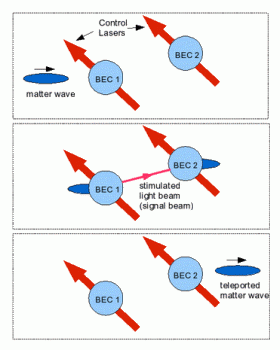Soon you will be beamed to your work – Star Trek style!
The stocks of auto industry and airlines is going to fall.. and fall heavily! Captain Kirk’s "transport" mechanism of making a guy stand on a circle and teleport him/her to another ship is just around the corner. Australian scientists are at it..
Teleportation, a concept popularised in the original Star Trek television series, is edging closer to reality through work being conducted by theorists from The University of Queensland and Australian National University.
Researchers from UQ’s Australian Research Centre for Quantum Atom Optics (Dr Ashton Bradley, Dr Simon Haine and Dr Murray Olsen) and Australian National University (Joseph Hope) have proposed a new way of teleporting matter waves.
“We propose a scheme which allows an atom laser beam to disappear at one location and reappear at another,” Dr Bradley said.
“We feel that our scheme is closer in spirit to the original fictional concept,” Dr Haine said.
“What differentiates our scheme from what is usually termed quantum teleportation is that our scheme does not require the sender and receiver to share entangled states, as there is no measurement step involved in sending the information.
"In this scheme the sender and receiver require a reservoir of extremely cold atoms, known as a Bose-Einstein condensate (BEC).
"BEC is a state of matter that occurs when atoms become very cold, (about 100 billionths of a degree about absolute zero).
"Due to a phenomenon known as Bose-Enhancement, all the atoms like to act the same way. This causes the atoms to act as one macroscopic matterwave, rather than a collection of individual atoms.”
Dr Haine said that sending a pulse of atoms towards a trapped condensate (BEC) and illuminating them with a control laser beam, the atoms from the pulse were stimulated to act the same way as the atoms already trapped in the BEC.
This resulted in the emission of a photon. As all the atoms in the BEC had a very well-defined momentum, the photons being emitted would follow the same direction and form a signal beam.
"We can arrange the position and momentum of each atom (quantum information) to be encoded onto the signal beam by carefully adjusting the intensity and wavelength of the control beam,” Dr Haine said.
The signal beam is then sent to a second BEC, which is also illuminated with a control laser. The atoms trapped in the BEC absorb the photon from the signal beam, and in turn are forced to emit the photon into the control beam.
Due to the momentum of releasing the photons, the atoms are kicked out of the BEC. These atoms contain the quantum information of the original atomic pulse which has been transferred to the new pulse, effectively teleporting the original pulse of atoms.
"Our scheme is quite different from what is usually coined quantum teleportation because it gets around the need for the sender and receiver to share entanglement, as the quantum state to be teleported is never actually measured," Dr Bradley said.
"As our scheme doesn’t rely on the quality of the entanglement, it may be possible to achieve more accurate teleportation via this method," he said.
Dr Bradley said the team would now embark on more detailed calculations, which took into account more complicated effects including the effects of the atoms colliding with each other, which could degrade the fidelity of the teleportation.
Powered by Qumana




